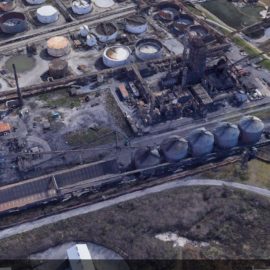
The EPA dropped the investigation into the LDPA on toxic gases. So we will never know.
The federal Environmental Protection Agency on Tuesday abruptly announced it was ending civil rights investigations of the state Department of Environmental Quality and Department of Health over their roles in issuing permits for petrochemical plants near Black communities in St. John the Baptist and St. James parishes. The decision brought harsh criticism from environmental groups that have been pushing the EPA to act more forcefully to address pollution in low-income and Black neighborhoods of the state. EPA head Michael Regan has spoken of making environmental justice concerns a cornerstone of his tenure, and has visited the Louisiana region activists label “Cancer Alley” twice since 2021. In announcing the decision, the EPA signaled its own actions were achieving results despite an inability to reach agreement with DEQ over the civil rights probe. The head of EPA’s civil rights office said investigations into two civil rights complaints filed with the agency by environmental groups in both parishes were closed after lengthy “informal resolution agreement” negotiations with representatives of both state agencies ended in failure. It made the announcement in letters sent to the secretaries of the two state departments and filed in federal court in Lake Charles.
nola.com
EPA only talks about emissions not the entrenched racism.
EPA cited its own court actions against Denka Performance Elastomers in Reserve and the recent announcement of proposed regulations that will significantly reduce emissions of chloroprene, classified as likely cancer-causing, at Denka and ethylene oxide at both Denka and Formosa Plastics’ proposed Sunshine Project in St. James. It said emissions will be reduced from both plants by 96% in nearby Black neighborhoods. EPA said it would also begin a new analysis near the Denka facility called a “cumulative impact assessment,” which is not under the agency’s regulations involving Title VI of the Civil Rights Act, and “would not impose any obligations on the state agencies.” That investigation will review potential exposures to combinations of chemicals and non-chemical stressors “and their effects on health, well-being, and quality of life outcomes.” EPA proposes to convene a “multi-stakeholder workgroup of locally affected parties,” which would create a charter describing “roles, responsibilities, goals of the (assessment), deliverables, and timeline for those deliverables.” “Participation by LDEQ and LDH, while not required, would be valuable in identifying problems and potential intervention and decision points to improve community health and well-being,” said the letter, signed by Lillian Dorka, EPA’s deputy assistant administrator for external civil rights.
Now they are looking at the Clean Air Act.
The letters were filed by EPA in the record of a federal lawsuit filed against the agency in May by Louisiana Attorney Gen. Jeff Landry. Landry asked a federal judge to declare EPA’s attempts to force chemical plants to implement greater reductions in air pollution in areas of the state where higher minority and low-income populations resided as both unconstitutional and in violation of the Clean Air Act. Landry’s lawsuit was directly aimed at the actions taken by EPA after the civil rights complaints filed by environmental groups involving Denka and Formosa Plastics. In the suit, Landry charged Regan with allowing his agency’s actions to be directed by activist groups, including the Sierra Club, Concerned Citizens of St. John, Louisiana Bucket Brigade, Stop the Wallace Grain Terminal, Inclusive Louisiana and Rise St. James, all of which have focused their efforts on reducing emissions from plants in what they call “Cancer Alley,” the industrialized strip along the Mississippi River between Baton Rouge and New Orleans. “No matter their intentions, the federal government should not be intimidating state agencies operating under an elected governor and an elected legislature. Our office is defending Louisiana against an unlawful assault by the EPA on our river-based communities and the employers who live in and contribute to our economy. We will continue to oppose this coordinated and misguided attack,” said Louisiana Solicitor General Liz Murrill. Denka also criticized EPA in a statement welcoming the decision. “Today’s decision by EPA to close its ill-conceived civil rights investigation is a reminder that the agency should turn its resources and attention to science, not politics,” it said in a statement. “DPE continues to vigorously defend itself against EPA’s unprecedented lawsuit against the company, yet the agency continues to ignore DPE’s dramatically reduced chloroprene emissions – as verified by a continuous fenceline monitoring system – as well as the company’s repeated calls to apply the best available science for the benefit of the community.”
Chloroprene is the question – how much can we breath in.
In a 2010 study, EPA determined that a typical person could be exposed to no more than an average 0.2 micrograms per cubic meter of chloroprene in the air over a 70-year lifetime without being expected to exceed a 1-in-10,000 risk of contracting chloroprene-linked cancers. And a child could only be expected to breathe an average concentration of no more than 1.2 micrograms per cubic meter from birth to their second birthday without being expected to exceed that same level of risk. Both DEQ and Denka have pointed out that the 0.2 micrograms per cubic meter level is a goal and not a federal or state standard. In 2017, Denka signed a consent agreement with the state to reduce its emissions from the plant by 85%, which it says it has done. Denka’s May emissions monitoring report to DEQ says the average released for the month was 1.09 micrograms per cubic meter, though some monitors also reported individual measurements as high as 4 micrograms and 10 micrograms on at least one day. Earthjustice, which represents Concerned Citizens of St. John in the civil rights complaint, criticized EPA’s decision. “We are deeply disappointed by EPA’s decision to close an investigation that could have brought justice to the community members of St. John the Baptist Parish, who have long borne the brunt of environmental injustice and discrimination,” said Earthjustice Vice President Patrice Simms. “Title VI is a critical tool that EPA must use to bring relief to communities like St. John so that they can breathe clean air. EPA’s decision to abandon its civil rights enforcement effort deprives these communities of an important avenue for securing justice and addressing longstanding and unconscionable toxic exposures.”
Others faulted the EPA.
Mary Hampton, president of Concerned Citizens, said she also was disheartened by EPA’s decision. “EPA agreed that what’s happening to us is unfair,” she said, referring to the agency’s October 2022 “letter of concern” to the state agencies in which it questioned whether they were adequately protecting the state’s Black and poor residents. “We thought the administration would protect us, but no one wants to stand up to these companies. We are suffering, we are dying, and this makes us feel like our lives don’t matter. That’s a hard thing to deal with.” Lisa Jordan, director of the Tulane Environmental Law Clinic, which also represents members of several of the environmental groups in one of the civil rights complaints, said “EPA’s own data demonstrates that our clients in the industrial corridor suffer from among the highest health risks associated with industrial air pollution in the nation. Census data show that these same communities are majority Black.” “It is also patently evident after decades of community experience, and our experience as their lawyers, that our state environmental agencies will not protect these communities and, instead, continue to this day to amass more and more polluting facilities in these areas,” she said.
LDEQ was happy as their dirty secrets are still hidden.
The decision to end the civil rights investigations was welcomed by DEQ. “We appreciate EPA’s careful and thorough handling of the matter and are just glad it’s completed,” said spokesman Greg Langley. He said it was too soon to say whether DEQ officials would participate in EPA’s new investigation in St. John Parish. The health department did not respond to requests for comments on the EPA action.
A two pronged study and one was taken care of, the head, but the problem of the heart remains.



